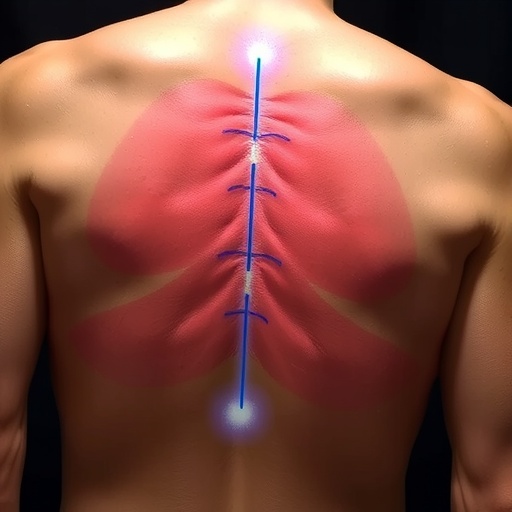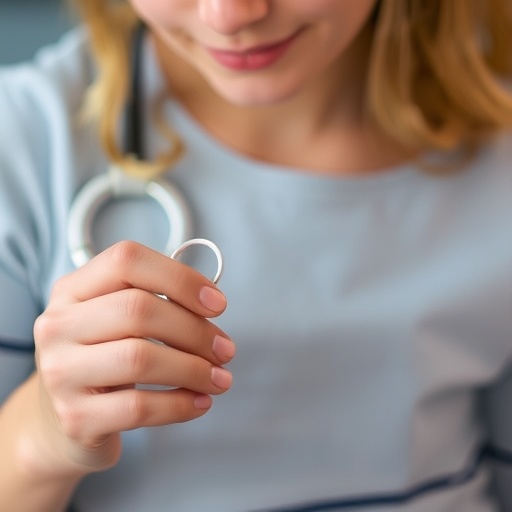A remarkable research study is propelling the field of neurosurgery into an era marked by innovative treatments that could redefine patient recovery experiences, particularly after spinal surgeries. Researchers led by Fouad, S., Rizk, A., and Mosbah, E. have unveiled a groundbreaking approach that combines the natural healing properties of platelet-rich fibrin with the advanced capabilities of silver nanoparticles loaded onto chitosan. This dynamic duo aims to combat the development of post-laminectomy epidural scar adhesions, a common yet debilitating issue faced by many patients following spinal surgery.
Post-laminectomy procedures, while often necessary, come with the risk of forming scar tissue that can lead to chronic pain, reduced mobility, and ancillary complications. These adhesions can result in significant discomfort, often necessitating further surgical interventions. Thus, the quest for therapeutic solutions that enhance healing while minimizing adverse effects has become imperative in contemporary medical research.
In this study, researchers launched an in vivo investigation using a rat model to assess the efficacy of their innovative treatment strategy. The dual application of platelet-rich fibrin—a substance rich in growth factors that promotes cell proliferation and tissue regeneration—and chitosan embedded with silver nanoparticles aimed to synergistically enhance healing. Chitosan is historically recognized for its biocompatibility and ability to facilitate wound healing, while silver nanoparticles have demonstrated potent antimicrobial properties, which can reduce infection risks during recovery.
The experimental design comprised meticulous surgical procedures to induce epidural adhesions in a controlled cohort of rats. Subsequent administration of the unique treatment regimen allowed researchers to closely monitor the healing process. Key parameters such as adhesion formation, inflammatory response, and overall tissue recovery were thoroughly evaluated through histopathological examinations and imaging techniques.
One particularly notable finding was the significant reduction in adhesion formation observed among the treated rats. By leveraging the growth factors inherent in platelet-rich fibrin, the research team observed a marked acceleration in tissue repair processes. This accelerated healing not only minimized the formation of unwanted scar tissue but also improved the surrounding tissue viability, further enhancing recovery outcomes.
Additionally, the incorporation of silver nanoparticles into the chitosan matrix presented an intriguing dimension to the study. These nanoparticles functioned not just as antimicrobial agents, but they also appeared to modulate the local inflammatory response. The researchers documented that the presence of silver played a crucial role in maintaining an optimal wound environment, thereby facilitating improved healing trajectories.
As the study progressed, the benefits of the treatment became increasingly evident. The researchers found that the integration of these two powerful modalities not only curtailed postoperative adhesion development but potentially provided a novel therapeutic avenue that could be applied to various surgical interventions beyond spinal surgery. The implications of these findings may extend to other areas of medicine, such as orthopedic surgery and trauma care.
The analysis included evaluations of pain levels and behavioral observations in the rat models, which further underscored the potential of this dual treatment approach. Animals receiving the platelet-rich fibrin and silver nanoparticle-chitosan treatment exhibited reduced signs of discomfort and better functional mobility compared to those in the control group, suggesting a transformative impact on recovery experiences.
In light of these promising outcomes, the researchers highlighted the necessity for further investigations, particularly clinical trials in human subjects. Conducting such trials would be pivotal in establishing safety profiles, optimal dosages, and application methods for this innovative therapy. If successful, this research could pave the way for a breakthrough in preventive measures against postoperative complications, reshaping the standard of care in neurosurgery and potentially other medical disciplines.
Sustainability is a vital consideration in the evolving landscape of medical treatments, and the continued exploration of natural and biocompatible materials, such as chitosan, is encouraging. As both researchers and clinicians increasingly seek innovative solutions that ensure patient safety and enhance overall recovery experiences, findings from this study could serve as a cornerstone in the development of future treatment protocols.
The emergence of regenerative medicine presents a thrilling frontier. With techniques focused on harnessing the body’s own healing capabilities, studies like this one could lead to advancements that render surgical recoveries less daunting. By using natural resources efficiently and effectively, the possibilities for chronic pain reduction may become a reality for countless individuals.
Overall, the collaborative effort of Fouad, Rizk, Mosbah, and their team reflects not only a commitment to advancing medical science but also an understanding of the intricate balance between innovation and patient care. By tackling pressing post-surgical complications head-on, these researchers have illuminated a pathway toward improved health outcomes, potentially revolutionizing how post-operative care is approached.
This research serves as a testament to the powerful intersection of biology and technology, highlighting how the marriage of traditional healing methods with cutting-edge advancements can yield transformative results. As we look ahead, the medical community remains hopeful that such innovations will become mainstream in clinical practice, ultimately enhancing the quality of life for patients worldwide.
In summary, the findings from this study signify a critical leap forward in the management of post-surgical complications. Acknowledging the potential for reduced adhesion formation and improved healing, it is essential for the medical community to support further research endeavors. As advancements in regenerative medicine continue to evolve, the emphasis on multidisciplinary approaches is more critical than ever to harness the full spectrum of therapeutic benefits available to patients.
Subject of Research: Treatment of post-laminectomy epidural scar adhesions using platelet-rich fibrin and chitosan embedded with silver nanoparticles.
Article Title: Platelet-rich fibrin and silver nano-particles loaded chitosan treatment for post- laminectomy epidural scar adhesions: in vivo rats study model.
Article References:
Fouad, S., Rizk, A., Mosbah, E. et al. Platelet-rich fibrin and silver nano-particles loaded chitosan treatment for post- laminectomy epidural scar adhesions: in vivo rats study model. BMC Neurosci 26, 10 (2025). https://doi.org/10.1186/s12868-025-00929-9
Image Credits: AI Generated
DOI:
Keywords: Platelet-rich fibrin, silver nanoparticles, chitosan, epidural scar adhesions, neurosurgery, regenerative medicine.
Tags: advanced healing techniques for patientsbiocompatible materials in medical researchchitosan-enhanced therapyepidural scar adhesions treatmentin vivo studies in neurosurgeryinnovative treatments for scar tissueplatelet-rich fibrin in neurosurgerypost-laminectomy recovery innovationsreducing chronic pain after surgerysilver nanoparticles in spinal surgeryspinal surgery complications managementtissue regeneration strategies





